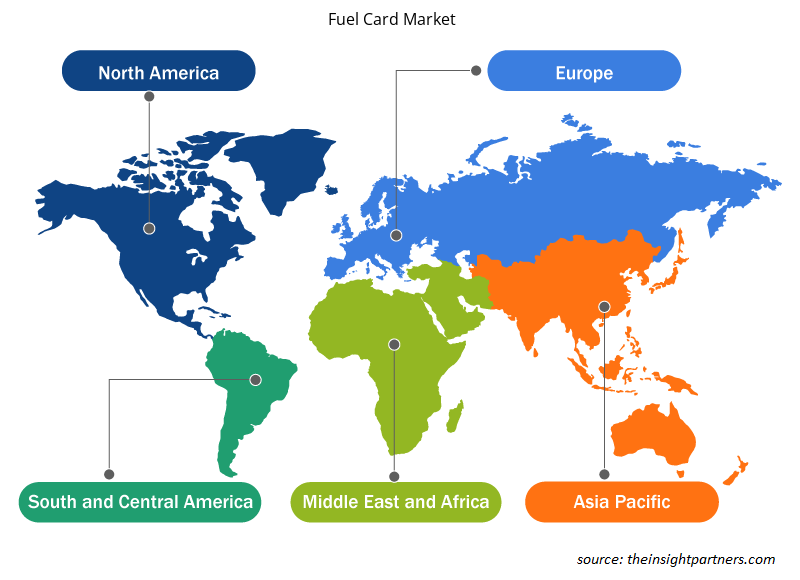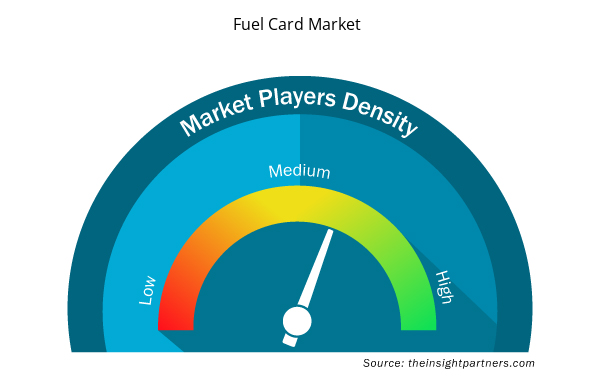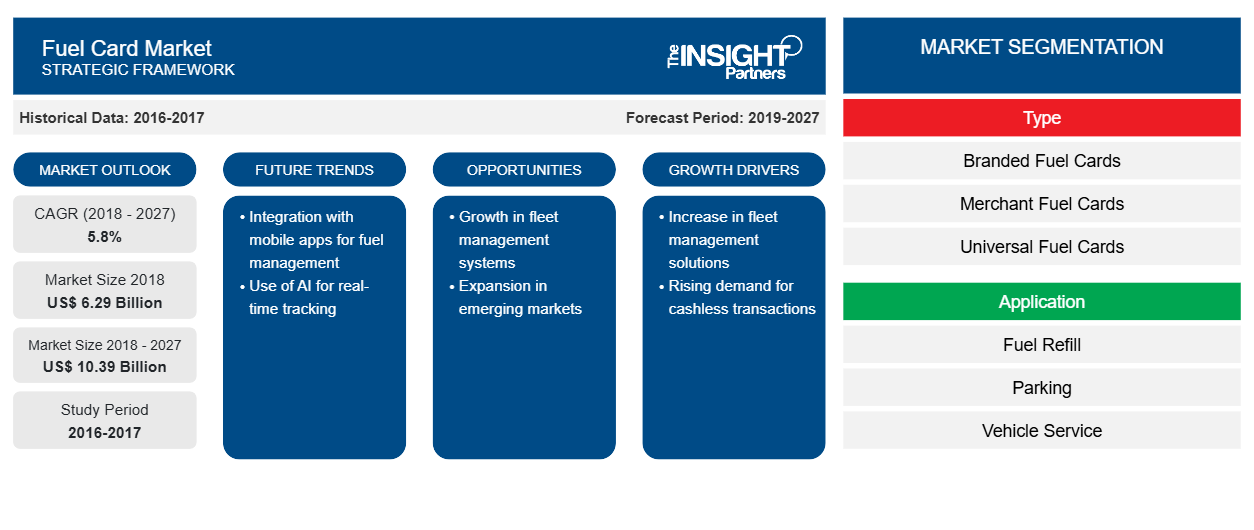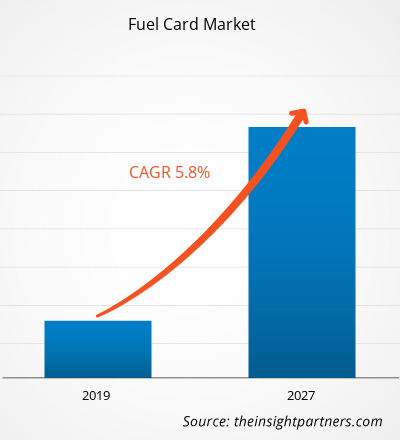[調査レポート] 世界の燃料カード市場は、2018年に62億9,000万米ドルに達すると推定され、2019年から2027年の予測期間中に5.8%のCAGRで成長し、2027年までに103億9,000万米ドルに達すると予想されています。
北米地域は、燃料カードの収益面で大きな市場シェアを占めており、予測期間を通じて市場シェアを独占し続けると予測されています。ユニバーサル カードは最も便利な燃料カード タイプで、これらのカードのプロバイダーは通常、複数の燃料会社と提携しており、優れた柔軟性を提供しています。一部の燃料カード会社は一部の国または地域でのみ運営されていますが、他の会社は特定のガソリンスタンドでのみ受け入れられる場合があります。地域の選択肢が少ないユーザーは、ガソリンスタンドを数か所に限定することに注意する必要があります。
燃料カード市場の洞察
強化されたデータキャプチャによる効率的な車両管理
燃料カードは、車両群の走行距離と燃料使用量をリアルタイムで追跡することで、車両群の経費と効率性の向上に役立ちます。車両群のオペレーターは、トラックのメンテナンス、トラックの修理、燃料、トラックの清掃、代替車両のレンタルなどの費用に燃料カードを使用します。燃料カードによって取得されるデータには、走行距離計の読み取り値、燃料グレード、燃料製品、燃料の量、車両 ID、ドライバー ID、税金情報、および時間、場所、支出額、日付などの取引詳細が含まれ、車両群管理者の豊富な再パワーアップをサポートします。この要因は、予測期間中の燃料カード市場の需要を促進するでしょう。
要件に合わせてレポートをカスタマイズする
このレポートの一部、国レベルの分析、Excelデータパックなど、あらゆるレポートを無料でカスタマイズできます。また、スタートアップや大学向けのお得なオファーや割引もご利用いただけます。
- このレポートの主要な市場動向を入手してください。この無料サンプルには、市場動向から見積もりや予測に至るまでのデータ分析が含まれます。
燃料カードの使用に伴う不正リスクの低減
燃料カードの使用は、小口現金などの燃料の支払い方法に比べて、機能性とセキュリティの面でメリットがあります。カードには、車両登録番号、運転手の名前、会社名を刻印することができ、不正使用や給油カードに対するさらなる保護を提供します。すべての燃料取引に関する包括的な情報により、従業員による不正使用の可能性が減り、正当な車両使用に対する優れた管理が可能になります。そのため、世界中の燃料カード市場は成長すると予想されています。
タイプセグメントの洞察
燃料カード市場は、コンポーネント別に、ブランド燃料カード、マーチャント燃料カード、ユニバーサル燃料カードに分類されます。燃料カードは通常、中小企業や大企業が燃料消費量を追跡し、キャッシュレス決済を便利に行うために使用されます。このようなカードは、輸送や車両管理を扱う企業や組織で最も一般的です。この分野で活動しているさまざまな企業が、さまざまなカードタイプを提供しています。これらのカードは、燃料の補充以外にも、さまざまな目的で使用されます。発行者による燃料カードは、大きく分けて独立型またはブランド型のカテゴリに分類できます。
アプリケーションセグメントの洞察
世界の燃料カード市場は、用途別に燃料補給、駐車、車両サービス、通行料、その他に分類されています。燃料カードを使用すると、ユーザーと事業主は燃料とメンテナンス費用を管理および制御できます。燃料カードは通常、ガソリンスタンドでの燃料の支払いカードとして使用されます。さらに、これらのカードは、修理、メンテナンス、ロードサイドアシスタンスなどの他の車両サービスの支払いにも使用できます。幅広いレポート機能により、いくつかの燃料カードでは、ユーザーがリアルタイムのレポートを取得できるため、車両税の管理とともにすべての事業費用を最新の状態に保つことができます。
燃料カード市場の地域別分析
予測期間を通じて燃料カード市場に影響を与える地域的な傾向と要因は、Insight Partners のアナリストによって徹底的に説明されています。このセクションでは、北米、ヨーロッパ、アジア太平洋、中東、アフリカ、南米、中米にわたる燃料カード市場のセグメントと地理についても説明します。

- 燃料カード市場の地域別データを入手
燃料カード市場レポートの範囲
| レポート属性 | 詳細 |
|---|---|
| 2018年の市場規模 | 62億9000万米ドル |
| 2027年までの市場規模 | 103.9億米ドル |
| 世界のCAGR(2018年 - 2027年) | 5.8% |
| 履歴データ | 2016-2017 |
| 予測期間 | 2019-2027 |
| 対象セグメント | タイプ別
|
| 対象地域と国 | 北米
|
| 市場リーダーと主要企業プロフィール |
|
市場プレーヤーの密度:ビジネスダイナミクスへの影響を理解する
燃料カード市場は、消費者の嗜好の変化、技術の進歩、製品の利点に対する認識の高まりなどの要因により、エンドユーザーの需要が高まり、急速に成長しています。需要が高まるにつれて、企業は提供内容を拡大し、消費者のニーズを満たすために革新し、新たなトレンドを活用し、市場の成長をさらに促進しています。
市場プレーヤー密度とは、特定の市場または業界内で活動している企業または会社の分布を指します。これは、特定の市場スペースに、その市場規模または総市場価値に対してどれだけの競合相手 (市場プレーヤー) が存在するかを示します。
燃料カード市場で事業を展開している主要企業は次のとおりです。
- BP社
- エクソンモービル株式会社
- フリートコアテクノロジーズ株式会社
- ロイヤル・ダッチ・シェル
- 米国銀行
免責事項:上記の企業は、特定の順序でランク付けされていません。

- 燃料カード市場のトップキープレーヤーの概要を入手
いくつかの市場イニシアチブは、世界の燃料カード市場で最も採用されている戦略であることが確認されました。最近の市場イニシアチブのいくつかを以下に示します。
2019: エデンレッド キャピタル パートナーズは、エデンレッドの活動に関連する分野で高い成長の可能性を秘めた革新的なビジネスに投資します。その目的は、支援先企業との価値ある相乗効果を生み出すことで、グループのエコシステムを強化することです。
2018: 企業、従業員、商店向けのトランザクション ソリューションの世界的リーダーであるエデンレッドは本日、英国第 4 位の燃料カード プログラム マネージャーである The Right Fuelcard Company (TRFC) グループの株式資本の 80% を取得する契約を締結したことを発表しました。
世界の燃料カード市場のセグメンテーション
世界の燃料カード市場 – タイプ別
- ブランド燃料カード
- 加盟店ブランドの燃料カード
- ユニバーサル燃料カード
世界の燃料カード市場 – アプリケーション別
- 燃料補給
- 駐車場
- 車両サービス
- 通行料金
- その他
世界の燃料カード市場 – 地域別
北米
- 私たち
- カナダ
- メキシコ
ヨーロッパ
- フランス
- ドイツ
- イタリア
- 英国
- スペイン
- その他のヨーロッパ
アジア太平洋(APAC)
- 中国
- インド
- 日本
- オーストラリア
- その他のアジア太平洋地域
中東・アフリカ(MEA)
- サウジアラビア
- アラブ首長国連邦
- 南アフリカ
- その他の中東およびアフリカ
南アメリカ
- ブラジル
- 南米のその他の地域
世界の燃料カード市場 - 企業プロファイル
- BP社
- エクソンモービル株式会社
- フリートコアテクノロジーズ株式会社
- ロイヤル・ダッチ・シェル
- 米国銀行
- 株式会社ウェックス
- DKV
- ワールドフューエルサービス
- エデナード
- Radius 決済ソリューション。
Allstar、Arco、Caltex、Chevron Texaco、Commdel、EDC、Engen Petroleum Ltd.、FastFuel、Fleetcare Pty Ltd、fuelGenie、Fuelman は、バリュー チェーンの他の市場プレーヤーであり、レポートには記載されていませんが、リクエストに応じて含めることができます。
- 過去2年間の分析、基準年、CAGRによる予測(7年間)
- PEST分析とSWOT分析
- 市場規模価値/数量 - 世界、地域、国
- 業界と競争環境
- Excel データセット


- Skin Graft Market
- Print Management Software Market
- Social Employee Recognition System Market
- Green Hydrogen Market
- Clinical Trial Supplies Market
- Nuclear Decommissioning Services Market
- Investor ESG Software Market
- Long Read Sequencing Market
- Occupational Health Market
- Non-Emergency Medical Transportation Market

Report Coverage
Revenue forecast, Company Analysis, Industry landscape, Growth factors, and Trends

Segment Covered
This text is related
to segments covered.

Regional Scope
North America, Europe, Asia Pacific, Middle East & Africa, South & Central America

Country Scope
This text is related
to country scope.
Trends and growth analysis reports related to Banking, Financial Services, and Insurance : READ MORE..
The List of Companies
- BP P.L.C.
- Exxon Mobil Corporation
- Fleetcor Technologies, Inc.
- Royal Dutch Shell plc
- U.S. Bank
- Wex Inc.
- DKV
- World Fuel Services
- Edenerd
- Radius Payment Solutions
The Insight Partners performs research in 4 major stages: Data Collection & Secondary Research, Primary Research, Data Analysis and Data Triangulation & Final Review.
- Data Collection and Secondary Research:
As a market research and consulting firm operating from a decade, we have published and advised several client across the globe. First step for any study will start with an assessment of currently available data and insights from existing reports. Further, historical and current market information is collected from Investor Presentations, Annual Reports, SEC Filings, etc., and other information related to company’s performance and market positioning are gathered from Paid Databases (Factiva, Hoovers, and Reuters) and various other publications available in public domain.
Several associations trade associates, technical forums, institutes, societies and organization are accessed to gain technical as well as market related insights through their publications such as research papers, blogs and press releases related to the studies are referred to get cues about the market. Further, white papers, journals, magazines, and other news articles published in last 3 years are scrutinized and analyzed to understand the current market trends.
- Primary Research:
The primarily interview analysis comprise of data obtained from industry participants interview and answers to survey questions gathered by in-house primary team.
For primary research, interviews are conducted with industry experts/CEOs/Marketing Managers/VPs/Subject Matter Experts from both demand and supply side to get a 360-degree view of the market. The primary team conducts several interviews based on the complexity of the markets to understand the various market trends and dynamics which makes research more credible and precise.
A typical research interview fulfils the following functions:
- Provides first-hand information on the market size, market trends, growth trends, competitive landscape, and outlook
- Validates and strengthens in-house secondary research findings
- Develops the analysis team’s expertise and market understanding
Primary research involves email interactions and telephone interviews for each market, category, segment, and sub-segment across geographies. The participants who typically take part in such a process include, but are not limited to:
- Industry participants: VPs, business development managers, market intelligence managers and national sales managers
- Outside experts: Valuation experts, research analysts and key opinion leaders specializing in the electronics and semiconductor industry.
Below is the breakup of our primary respondents by company, designation, and region:

Once we receive the confirmation from primary research sources or primary respondents, we finalize the base year market estimation and forecast the data as per the macroeconomic and microeconomic factors assessed during data collection.
- Data Analysis:
Once data is validated through both secondary as well as primary respondents, we finalize the market estimations by hypothesis formulation and factor analysis at regional and country level.
- Macro-Economic Factor Analysis:
We analyse macroeconomic indicators such the gross domestic product (GDP), increase in the demand for goods and services across industries, technological advancement, regional economic growth, governmental policies, the influence of COVID-19, PEST analysis, and other aspects. This analysis aids in setting benchmarks for various nations/regions and approximating market splits. Additionally, the general trend of the aforementioned components aid in determining the market's development possibilities.
- Country Level Data:
Various factors that are especially aligned to the country are taken into account to determine the market size for a certain area and country, including the presence of vendors, such as headquarters and offices, the country's GDP, demand patterns, and industry growth. To comprehend the market dynamics for the nation, a number of growth variables, inhibitors, application areas, and current market trends are researched. The aforementioned elements aid in determining the country's overall market's growth potential.
- Company Profile:
The “Table of Contents” is formulated by listing and analyzing more than 25 - 30 companies operating in the market ecosystem across geographies. However, we profile only 10 companies as a standard practice in our syndicate reports. These 10 companies comprise leading, emerging, and regional players. Nonetheless, our analysis is not restricted to the 10 listed companies, we also analyze other companies present in the market to develop a holistic view and understand the prevailing trends. The “Company Profiles” section in the report covers key facts, business description, products & services, financial information, SWOT analysis, and key developments. The financial information presented is extracted from the annual reports and official documents of the publicly listed companies. Upon collecting the information for the sections of respective companies, we verify them via various primary sources and then compile the data in respective company profiles. The company level information helps us in deriving the base number as well as in forecasting the market size.
- Developing Base Number:
Aggregation of sales statistics (2020-2022) and macro-economic factor, and other secondary and primary research insights are utilized to arrive at base number and related market shares for 2022. The data gaps are identified in this step and relevant market data is analyzed, collected from paid primary interviews or databases. On finalizing the base year market size, forecasts are developed on the basis of macro-economic, industry and market growth factors and company level analysis.
- Data Triangulation and Final Review:
The market findings and base year market size calculations are validated from supply as well as demand side. Demand side validations are based on macro-economic factor analysis and benchmarks for respective regions and countries. In case of supply side validations, revenues of major companies are estimated (in case not available) based on industry benchmark, approximate number of employees, product portfolio, and primary interviews revenues are gathered. Further revenue from target product/service segment is assessed to avoid overshooting of market statistics. In case of heavy deviations between supply and demand side values, all thes steps are repeated to achieve synchronization.
We follow an iterative model, wherein we share our research findings with Subject Matter Experts (SME’s) and Key Opinion Leaders (KOLs) until consensus view of the market is not formulated – this model negates any drastic deviation in the opinions of experts. Only validated and universally acceptable research findings are quoted in our reports.
We have important check points that we use to validate our research findings – which we call – data triangulation, where we validate the information, we generate from secondary sources with primary interviews and then we re-validate with our internal data bases and Subject matter experts. This comprehensive model enables us to deliver high quality, reliable data in shortest possible time.


 このレポートの無料サンプルを入手する
このレポートの無料サンプルを入手する